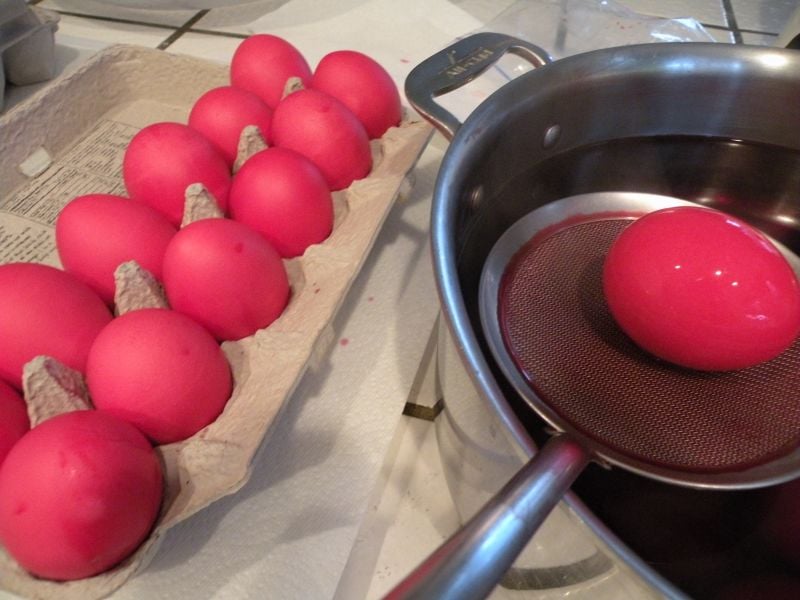
Growing up in a Greek family during the Easter holidays everyone awaits the excitement of “cracking” of the red eggs with friends and family on Easter Sunday. Traditionally, the Greek Red Easter Eggs are dyed on Holy Thursday, but today in modern times they are done on any day close to Easter Sunday. Red symbolizes the blood of Christ shed on the cross. Some consider the first egg dyed as the egg of the Virgin Mary and save it in their home to protect the household from the evil eye. Others save the egg from church service during the Anastisi, the midnight service on Saturday.
The eggs are cracked large end to large end or small end to small end. Once you’re egg is fully cracked on each side, it’s time to eat it! But, if you hold the egg the hasn’t been cracked, you have been given good luck for the year. While you crack you’re eggs, one person will say, “Christos Anesti”, while the other person says, ” Alithos Anesti”., symbolizing Christ’s emergence from the tomb. This is the first food eaten after fasting.
Along with the eggs, the Greek bread ” tsoureki” is made with several red eggs woven in the bread. The bread dough is made with three braids signifying the Trinity. The traditional Easter soup, mayeristsa, is also shared among the family. This delicate soup with it’s lamb parts is considered a gentle way to introduce meat back into the diet.
If you would like the recipe and more information read here.
Every dye package has it’s own directions. So, try and follow your brands cooking steps. I buy mine at the Greek stores in town. If you can’t find a local store, you can find them online. I suggest you buy more than one for the upcoming years. The following is a basic egg cooking process I have used. An alternative to using this egg dye is to use natural foods to dye your eggs.
Place room temperature eggs with cold water in a large pan. Try and have most of the eggs in a single layer. Bring to a gentle boil, and reduce to medium low and cook for 15-20 minutes. To test your egg to see if it done, spin the egg on your counter. If it spins slowly, it’s done. You may also want to remove an egg and break it open to make sure it’s hard boil.
Once the eggs are boiled, dissolve the dry red dye in a glass of water and pour in your pan. Stir in one cup of vinegar and stir gently. Cover and let it sit until it gets to the shade you would like.
With a spoon slowly lift your egg out of the pan to see the color. Place it back gently if it needs more time.
With a slotted spoon slowly lift each egg out and place back in the original egg carton. This is a great container for drying, as well as for storing your finished eggs.
Allow the eggs to cool. To shine your eggs, use a paper towel and oil and rub each egg gently to cover the egg. Place back in container and refrigerate.
Information from: The Greek Traditions and Customs in America by Marilyn Rouvelas
© 2012 – 2018, Mary Papoulias-Platis. All rights reserved.
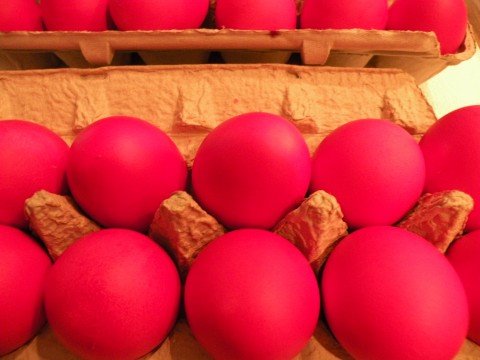
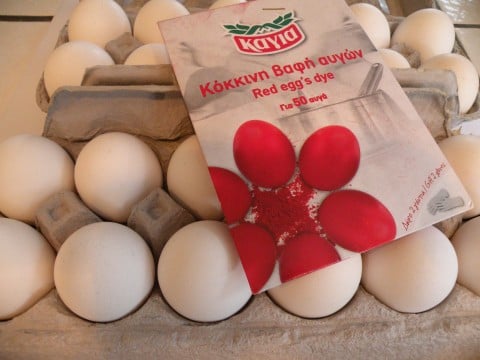
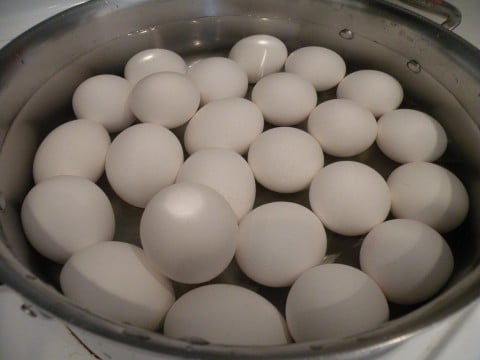
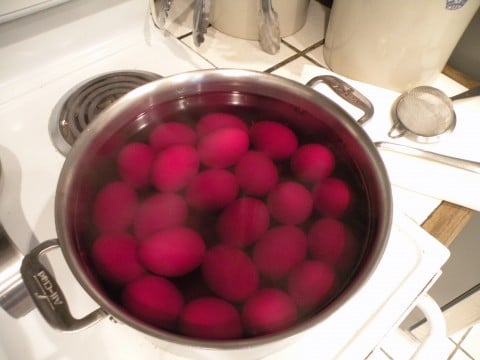
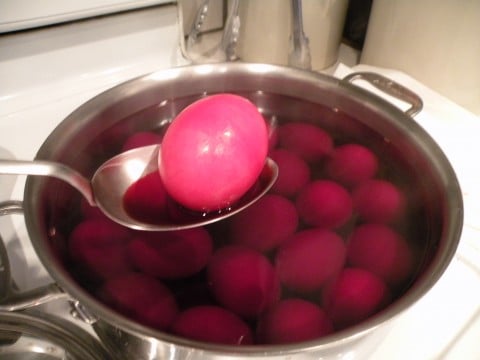
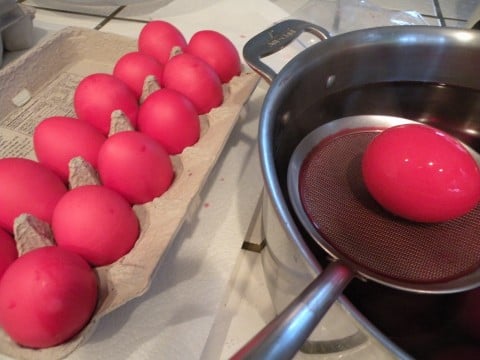
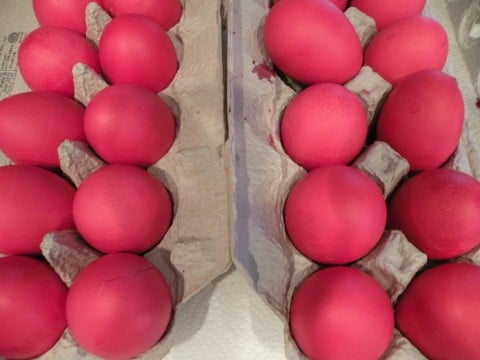







{ 17 comments… read them below or add one }
We’ve always added boiled the eggs in the dye. The result is a much deeper red.
Appreciate the tip about spinning the egg !
Christos Anesti!
Thanks for posting this! 🙂 Great info as we approach Pascha again.
Question – last year was my first year doing this, and the paper towels I was using to polish the eggs seemed to scratch off the color instead. Did I do anything wrong, or does that happen?
Thanks!
Yes, that happens when the paper is rough, but I tried it with an old cotton sheet I had, and the same thing happened. You can use a pastry brush and just brush lightly with olive oil. Thank you for the comment. Kalo Pascha!
Your blog is a great discovery! This year a Facebook friend told me her secret was to add beet juice to the dye and they were by far the best color I ever got.
When I dye my Greek eggs red they always come out all spotted and marbeled looking. I follow the dye package directions, (Krinos brand), but I have had no luck with achieving a pretty solid red color on my eggs. What am I doing wrong? Please Help Me!! Thank You!
I never get the eggs deep red. I have done 2 double the dye in the pot, I have added onion peel to the dye, I have even made double dye in cool water and add the cooked dull eggs in that. I have done it separate, and all those technique together.. I need help.
The egg dyes are different from company to company. My packet said to add vinegar to the dye. Did your packet list vinegar? Next time wash your eggs and dry them, if you don’t but organic they sometimes they have a film on them. Try and dissolve the dye first in a warm glass of water, then add to pot. Best of luck! Kali Anastisi!
Alithos Anesti! Have a blessed Easter!
Yes, my mother did that trick and it works. I also soak them overnight in the dye!
Oh Eleni so sorry! Eggs sometimes have a film on them, so prewash and dry them before coloring. Try dissolving the dye first in warm water and then add the dye to the pot with vinegar, about 1 cup. Good Luck!
Using brown eggs works better
I’m happy to hear that, because I often buy brown eggs. Thank you for the tip!
Interesting method. I was taught at a young age if the egg spins and doesn’t wobble, then it’s hard boiled.
Olga, isn’t that a great tip! It works everytine.
Mary
How can I stop the red dye seeping into the egg !
Hi Irene,
That happens to me as well. Keep your eggs on simmer, and that helps them from cracking. I haven’t found solution to the problem yet.
Happy Easter,
Mary